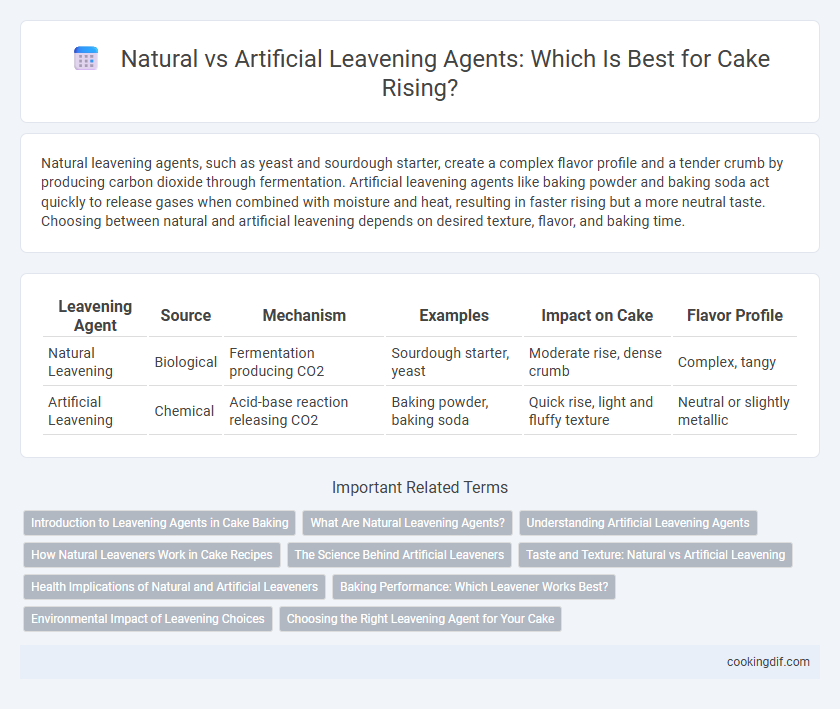Natural leavening agents, such as yeast and sourdough starter, create a complex flavor profile and a tender crumb by producing carbon dioxide through fermentation. Artificial leavening agents like baking powder and baking soda act quickly to release gases when combined with moisture and heat, resulting in faster rising but a more neutral taste. Choosing between natural and artificial leavening depends on desired texture, flavor, and baking time.
Table of Comparison
| Leavening Agent | Source | Mechanism | Examples | Impact on Cake | Flavor Profile |
|---|---|---|---|---|---|
| Natural Leavening | Biological | Fermentation producing CO2 | Sourdough starter, yeast | Moderate rise, dense crumb | Complex, tangy |
| Artificial Leavening | Chemical | Acid-base reaction releasing CO2 | Baking powder, baking soda | Quick rise, light and fluffy texture | Neutral or slightly metallic |
Introduction to Leavening Agents in Cake Baking
Leavening agents in cake baking function by producing gas that creates air pockets, crucial for a light and airy texture. Natural leavening agents like yeast and sourdough release carbon dioxide through fermentation, imparting distinct flavors and denser crumb structure. Artificial leaveners such as baking powder and baking soda chemically react to produce carbon dioxide rapidly, enabling consistent rise and fine crumb in a shorter baking time.
What Are Natural Leavening Agents?
Natural leavening agents, such as yeast and sourdough starter, rely on wild or cultivated microorganisms to produce carbon dioxide, which causes dough to rise. These agents create complex flavors and enhance texture through fermentation, contrasting with the more predictable and faster action of artificial leavening agents like baking powder or baking soda. Using natural leavening results in cakes with a richer taste profile and a tender crumb, favored in artisanal baking.
Understanding Artificial Leavening Agents
Artificial leavening agents, such as baking powder and baking soda, play a crucial role in cake baking by producing carbon dioxide gas to create rise and lightness. These agents consist of chemical compounds that react swiftly when exposed to moisture and heat, making them highly reliable for consistent and controlled leavening. Understanding their precise function allows bakers to achieve desired texture and volume, distinguishing them from natural agents like yeast that rely on fermentation processes.
How Natural Leaveners Work in Cake Recipes
Natural leaveners in cake recipes primarily rely on biological fermentation, where yeast or sourdough cultures produce carbon dioxide gas that creates air pockets in the batter, resulting in a light and fluffy texture. Ingredients like buttermilk or yogurt provide acidity which reacts with baking soda to release carbon dioxide, enhancing the rise without artificial additives. This slow fermentation process also contributes subtle tangy flavors and improves the overall crumb structure compared to artificial leavening agents like baking powder.
The Science Behind Artificial Leaveners
Artificial leavening agents such as baking soda and baking powder release carbon dioxide gas when reacting with moisture and heat, creating air bubbles that cause dough or batter to rise. These chemical reactions are precisely calibrated for consistent leavening, providing reliable texture and volume in cakes compared to natural leaveners like yeast. Understanding the roles of acid-base reactions in artificial leaveners optimizes cake structure and crumb development for desired lightness and tenderness.
Taste and Texture: Natural vs Artificial Leavening
Natural leavening agents like yeast produce complex flavors and a tender crumb due to slow fermentation, enhancing cake depth and moisture. Artificial leaveners such as baking powder and baking soda create rapid gas release, resulting in a lighter texture but sometimes a more neutral or slightly bitter taste. Choosing natural or artificial leavening impacts both the flavor profile and structural softness of cakes.
Health Implications of Natural and Artificial Leaveners
Natural leavening agents like yeast and sourdough promote gut health by supporting beneficial bacteria and reducing reliance on chemical additives. Artificial leavening agents such as baking powder and baking soda can cause digestive discomfort in sensitive individuals due to their high sodium content and rapid gas release. Choosing natural leaveners may enhance nutritional value and minimize adverse reactions compared to synthetic rising agents.
Baking Performance: Which Leavener Works Best?
Natural leavening agents like sourdough starter provide a complex, tangy flavor and slower fermentation, enhancing crumb structure and moisture retention in cakes. Artificial leavening agents such as baking powder and baking soda deliver consistent, rapid rise, producing a lighter, airier texture ideal for quick cakes. The best leavener depends on the desired cake characteristics; baking powder often excels in predictable rising performance, while natural leavens contribute more depth in flavor and texture complexity.
Environmental Impact of Leavening Choices
Natural leavening agents, such as sourdough starters, reduce environmental impact by minimizing reliance on industrially produced yeast and chemical additives, thereby lowering energy consumption and carbon emissions. Artificial leavening agents like baking powder and baking soda often involve energy-intensive manufacturing and generate more waste through packaging. Choosing natural leavening supports sustainable baking practices by promoting local ingredient sourcing and reducing the ecological footprint.
Choosing the Right Leavening Agent for Your Cake
Choosing the right leavening agent for your cake depends on the desired texture and flavor; natural agents like yeast and sourdough starters produce a complex flavor and airy crumb, while artificial agents such as baking powder and baking soda offer quick and reliable rise. Baking soda requires an acidic component like buttermilk or lemon juice to activate, making it ideal for recipes with natural acids, whereas baking powder contains both acid and base, allowing it to work independently. Understanding these differences ensures precise rising, optimal texture, and enhances the overall cake quality.
Natural vs Artificial leavening for rising agents Infographic

 cookingdif.com
cookingdif.com